Sects of Sikhism
Sikh sects, denominations, traditions, movements, sub-traditions, also known as sampardai (Gurmukhi: ਸੰਪਰਦਾ; saparadā) in the Punjabi language, are sub-traditions within Sikhism that believe in different approaches to practicing the religion. While all sampradas believe in the One Creator God typically rejecting both idol worship and caste systems. Different interpretations have emerged over time, some of which have a living teacher as the leader.[1][2] The major historic traditions in Sikhism, states Harjot Oberoi, have included Udasi, Nirmala, Nanakpanthi, Khalsa, Sahajdhari, Namdhari Kuka, Nirankari and Sarvaria.[3][4]
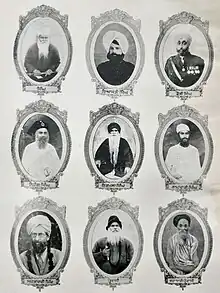
| Part of a series on |
| Sikhism |
|---|
 |
During the persecution of Sikhs by Mughals, several splinter groups emerged such as the Minas and Ramraiyas[5] during the period between the death of Guru Har Krishan and the establishment of Guru Tegh Bahadur as the ninth Sikh Guru. These sects have had considerable differences. Some of these sects were financially and administratively supported by the Mughal Empire in the hopes of gaining a more favorable and compliant citizenry.[2][5]
In the 19th century, Namdharis and Nirankaris sects were formed in Sikhism, seeking to reform and return to the Sikh faith to the "original ideology" of Sikhism.[6][7][8] They also accepted the concept of living gurus. The Nirankari sect, though unorthodox, was influential in shaping the views of Khalsa and the contemporary era Sikh beliefs and practices.[9][10] Another significant Sikh break off sect of the 19th century was the Radha Soami movement in Agra led by Shiv Dayal, who relocated it to Punjab.[11] Other contemporary era Sikhs sects include the 3HO Sikhism, also referred to as Sikh Dharma Brotherhood formed in 1971 for establishing the Sikh faith in the western hemisphere. This was led by Yogi Bhajan.[11][12][13] See also Dera (organization), non-Sikh Deras, for more examples of Sikh sects.
Early Sikh sects
These distinguished ways or paths are termed ‘sampardaya’ or 'samprada'. This term has, in the past, been wrongly mis-interpreted or conveyed to the public as ‘sects’ or a ‘cults’, terms that incorrectly imply deviation, arising from dissent with practiced beliefs. The term samparda does not mean ‘sect’, but rather order, as in an order of monks. In this sense, a sampardaya represents one among several mutually complementary orders. Each one of the major traditional sampardas claims to have began with the Gurus.
Panj Samparda (Gurmukhi: ਪੰਜ ਸੰਪਰਦਾਵਾਂ; pañj sampradāvā̃; meaning "five sects") is the collective name for the following five early sampradayas in Sikhism.
These include: Nihang Samparda, Udasi Samparda, Nirmala Samparda, Sevapanthi Samparda, and Giani Samparda (Damdami Taksal)
Udasi
| Part of a series on |
| Udasi |
|---|
 |
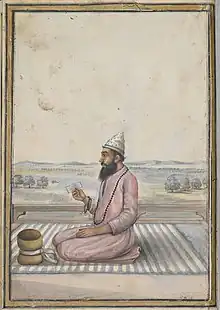
Udasi, derived from the Sanskrit word "Udasin",[14]: 78 meaning "detached, journey", reflecting an approach to spiritual and temporal life,[15] is an early sect based on the teachings of Guru Nanak's elder son Sri Chand (1494–1643), who, contrary to his father's emphasis on participation in society, propagated ascetic renunciation and celibacy.[15] Another Sikh tradition links the Udasis to Baba Gurditta, the eldest son of Guru Hargobind, and there is dispute on whether the Udasis originated with Sri Chand or Gurditta.[16] Udasis were some of the first proselytizers of Sikhism.
They maintain their own parallel line of gurus from Guru Nanak, starting from Sri Chand followed by Gurditta.[15] They first came to prominence in the 17th-century,[14] and gradually began to manage Sikh shrines and establishments in the 18th century,[17] from where they espoused a model of Sikhism that diverged considerably from that of the Khalsa.[14] They would set up establishments across North India through to Benares, where they would come to be ideologically joined with monastic asceticism.[14] The combination of Hindu devas and the Sikh religious text indicated that the sect evolved over time under many historical influences and conditions,[15] interpreting the message of Guru Granth Sahib in monistic Vedantic terms.[18] They were initially largely based in urban centers where they set up their establishments, or akharas, only beginning to spread into rural areas during Sikh rule.[15]
According to 18th-century descriptions, they either cut or matted hair under a turban, rather than a knot under a turban like Khalsas, and instead of the Khalsa emphasis on the panj kakkar garb and sporting arms, their dress code would include items such as a cap (seli topi), a cotton bag, a flower rosary, a vessel made of dried pumpkin, a chain around the waist, ash (vibhuti) to smear on their body, and a deerskin upon which to perform Hatha yoga, resulting in an extremely divergent appearance from Khalsa Sikhs in the eighteenth century.[14] The Udasis considered secular pursuits to be incompatible with personal salvation, which was to be achieved only through renouncing the world,[14] espousing asceticism and a monastic traveler lifestyle. Udasis are known for their Akharas along with the Nirmala sect of Sikhism. It is important to note that many Udasis actually took Amrit, and have become members of the Khalsa.
During the era between the martyrdom of Banda Singh Bahadur in 1716 and the rise of Ranjit Singh and the Sikh Empire, they were among the few sects able to build and manage Gurdwaras and train apprentices; they were scholars in both Sanskrit and Persian. They were respected and patronized through land grants during Sikh rule.[15] With a wide reach due to their syncretic nature between Sikhism and Hinduism, they were able to derive significant acceptance during the era of armed struggle in Punjab, bringing a large number of people into the Sikh fold during the 18th and the early 19th centuries.[19] They greet each other with "Om namo Brahmane,"[15] and attribute their origin to the mythic Sanandan Kumar, the son of Brahma.[18] When the Singh Sabha movement, dominated by Reformist Khalsa Sikhs, codified the Sikh identity in the early 20th century, the increasingly corrupt [20][21][22] and hereditary[23] Udasi mahants were expelled from the Sikh shrines.[24] After the standardization of Sikh identity after the Singh Sabha movement, the Udasis increasingly regarded themselves as Hindus rather than Sikhs.[17]
Jagiasi
_from_a_painting_titled_'Kings_and_other_devotees_paying_homage_to_Guru_Nanak'_from_the_Wellcome_collection%252C_circa_19th_century.jpg.webp)
Jagiasi, also known as Jagiasu or Jijnasu (from the Sanskrit word jijñāsā meaning "desire to know"), was a sister-sect to the Udasis, with the differences being that whilst the Udasi trace their origin to Sri Chand, Guru Nanak's eldest son, the Jagiasu claim to have been founded by Lakhmi Das, the younger son of Guru Nanak.[25][26][27][28] Another difference is while the Udasis follow a lifestyle of celibacy and aseticism, following in the footsteps of their founder, who was a recluse, the Jagiasu on the otherhand promote and live the life of a householder, known as grist marg.[25][26][27][28] The sect was prevalent during the period of Baba Gurupat (also known as Bawa Gurpat Saheb), who was a 12th generation descendent of Guru Nanak.[25][26][27][29][30] Baba Gurupat conducted missionary works in Sindh and founded many Jagiasu tikanas (seats; a term for a place of worship in many Sikh sects) in the region, specifically in Khairpur, Hyderabad, Halani, and Kandyaro.[25][26][27][29][30] Whilst they venerate the Guru Granth Sahib, they tend to forgo the Amrit Sanskar baptism ceremony to become initiated Khalsa but a few of them are Khalsas.[25][28] Furthermore, their beliefs and practices show tinges of religious syncretism with Hinduism.[25][26] They maintain a close relationship with and similarities to their sibling sect, the Udasis.[25][26][28]
Nirmala

Nirmalas are a Sikh tradition of ascetics.[31] According to their traditional beliefs, the Nirmala Sikh tradition was founded by Guru Gobind Singh in late 17th century when he sent five Sikhs to Varanasi (Kansi) to learn Sanskrit and Hindu religious texts.[32][33] Another tradition states that they originated during the time of Guru Nanak.[34] These beliefs, according to W. H. McLeod, are of doubtful historicity because they are "scarcely mentioned" in Sikh literature before the 19th century.[35] Jathedar Gurbachan Singh of the Giani Samparda (Sampardai Bhindra(n) also disagreed with this claim. Nirmalas are split into Bhai Daya Singh Samparda and Bhai Dharam Singh Samparda. Daya Singh and Dharam Singh were two of the panj pyare initiated by Guru Gobind Singh. Nanaksar is an offshoot of the Nirmala tradition.
The Nirmala Sikhs often wear ochre-colored robes (or at least one item), observe celibacy,[35] and keep kesh (unshorn hair).[36] They observe the same birth and death rituals as the Hindu ascetics and have an akhara (martial organization) in Haridwar,[36] and a number of deras in Punjab (India).[37] They have been one of the major procession participants in Kumbh Melas.[38][34] They were itinerant missionaries who traveled and spread Sikhism among the masses beyond Punjab, and were particularly active in Malwa within Punjab through Patiala and Phulkian state patronage during the 19th century,[35][34] thus making an important contribution to the growth of Sikhism.[39] They created many books and writings which explained some of the Sikh Scriptures, such as the famous Faridkot Teeka, which provides a complete exegesis of the Guru Granth Sahib, very similar to the Islamic tafsir. They often served as mahants in Sikh temples (gurdwaras) during the 18th century.[36] Nirmalas interpret Sikh literature in Vedantic terms.[33][39] During the Singh Sabha Movement of the late 19th century and early 20th century, some of their doctrines met with disapproval by the Tat Khalsa faction of Sikhs, though they continued to be accepted as Sikhs,[35] and were cordially regarded by the Sanatan faction.[35]
Sewapanthi

The Sewapanthi (also known as Sevapanthi or Addanshahi) is a traditional samprada of the Sikhs.[40][41] Sewapanthi is a compound word made up of the terms sewa, which means unselfish service, and panthi, panth, which in this case refers to the way, literally means "widened road." As a result, this phrase can be used to describe people who choose the route of unselfish service.[42] Sewapanthis wrote many commentaries on Sikh texts, known as steeks or teekas, and wrote many books & gave many lectures explores Hindu schools of thought, as well as Sufi Mysticism,[40] and famous Islamic writers such as Imam Al-Ghazali.
The sewapanthis emerged with Kanhaya Lal, a Dhamman (Dhiman) Khatri, and personal disciple of Guru Tegh Bahadur.[43] He was born in 1648 in the now-Pakistani town of Sohadara. Formerly a Mughal officer, he worked as a menial at the Guru's table day and night, bringing water to the horses and everyone else with him. He learned numerous Sikh spiritual principles from the Guru. In the rugged Attock district of Punjab's Northwest boundary, Bhai Kanhaiya built a dharamshala (Rest house and shrine).[42] The 10th Guru, Guru Gobind Singh, exempted Khanaiya and his followers from military duty and told him to carry on performing the duty allotted him by his reverend Guru Tegh Bahadur of serving all living beings.[42] In a later battle in Anandpur, Bhai Khanaiya served water indiscriminately to friend and foe alike. For this act, some angry Sikh warriors accused him of treason and brought him before Guru Gobind Singh.[43] When the Guru asked him why he was helping the wounded enemy, he replied that he could not distinguish between friend or foe as he could only see guru in all.[43] The Guru was pleased, and he then blessed him, saying after him shall be a Sikh order who will serve all mankind indiscriminately. Noor Shah was amongst the Mughal soldiers to whom Bhai Khanaiya had served water. He went onto become a great disciple of Bhai Khanaiya, setting up a Dharmsala of his own. Two of the most prominent followers were Seva Ram and Baba Adan Shah. As such, Sevapanthis are often referred to as Adan Shahi.[44]
The Seva Panthis are pacifists & themselves desist from all forms of violence.[42] Traditionally, the Sevapanthis were associated with the Sehajdharis, as evidenced by their names (Adan Shah, Seva Ram). They are strict pacifists, which is the reason they would forego Khande Ki Pahul. Some believe they were exempt from Pahul by Guru Gobind Singh. They are celibate and eat and share property together. They avoid meat, liquor, and cannabis and their dress is white. M.A Macauliffe described them as an orthodox and honourable sect who live by honest labour.
There are strong historical links between the Udasi and Sewapanthi orders. Very few sewapanthis exist today.
Akali/Nihang
Main Article: Nihang
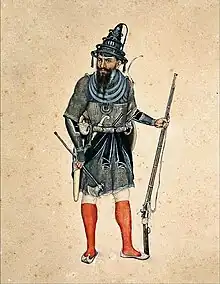
The armed Sikh warrior organization called the Nihangs or Akalis, which means "the immortals,"[45] was founded in the Indian subcontinent.[46] Nihangs are thought to have come from Guru Hargobind's "Akal Sena" (lit. "Army of the Immortal") or Baba Fateh Singh from the dress he wore.[47] The Nihangs dominated early Sikh military history and were renowned for their triumphs despite being vastly outnumbered. The Nihangs, who were originally the irregular guerrilla squads of the Sikh Khalsa Army, formed some parts of the armed forces of the Sikh Empire, and were historically renowned for their valor and cruelty on the battlefield.[46] There are four main factions amongst the Nihangs of the modern-era, them namely being: The Budha Dal, Tarna Dal, Bhidi Chand Dal, and Ranghreta Dal.[46] Nihang Samprada is also sometimes collectively called, Dal Khalsa.
The Budha Dal is the largest and most influential of all these 4 subsections. Some Nihang groups consume small amounts of crushed cannabis in a drink called shaheedi degh (ਭੰਗ), purportedly to help in meditation.[2] Shaheedi Degh without cannabis is called Shardai. Its consists of nuts, herbs some flowers, and a slight amount of cannabis.[48] Nihang Sikhs are also known for their practice of Jhatka.[49]
Nihangs often consider themselves as Kshatriyas, and that the whole Khalsa is Kshatriya. The Nihangs were particularly known for their high turbans (dastar bunga) and their extensive use of the chakram or war-quoit.[46] Their turbans were often pointed at the top and outfitted with a chand torra or trident called a gajga which could be used for stabbing in close-quarters. They also accept the Dasam and Sarbloh Granth scriptures as extensions of the Guru Granth Sahib.[50][46] Currently, Dal Khalsa is the largest it has ever been in its entire history.
Gianiaan Samparda [lower-alpha 1]
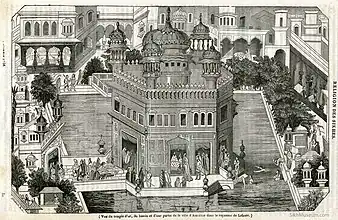
The Gyaaniyan (Giani) Samparda used to act as a teaching institute (sometimes known colloquialy as a bunga) for Sikhism.[51] Whilst technically not an order, it essentially serves as one. The "Gyanian Bunga" was present in Amritsar for at least a century before British hegemony. It was often made up from individuals belonging to all of the above orders. The Damdami Taksal alleges connection and lineage (pranali) with the order,[51][52] however this is a topic of contention. Others refer to it as "Samparda Bhindra(n)"
Damdami Taksaal is a school which claims a direct lineage of vidya to Guru Gobind Singh (via the Gianian Samparda). It still exists to this day and teaches thousands of people vidya and santhiya across the globe. In 1706, after the Battle of Muktsar, the army of Guru Gobind Singh camped at Sabo Ki Talwandi.[53] This acted as a damdamā, or halting place (lit. "breathing place"), and is now the site of Takht Sri Damdamā Sahib. That year, Guru Gobind Singh is said to have founded a distinguished school of exegesis (Taksal), later headed up by Baba Deep Singh.[53] Guru Gobind Singh reestablished the famous Anandpur Darbar of learning in Damdamā Sahib, as now this new location was considered to be the highest seat of learning for the Sikhs during the 18th century. Modern Damdami Taksal (Jatha Bhindran-Mehta) claims direct historical ties to Guru Gobind Singh,[54] who entrusted them with the responsibility of teaching the analysis (vichār/vidya) and recitation of the Sikh scriptures (santhya).[53] The word ṭaksāl (lit. 'mint') refers to an education institute; which is a community of students who associate themselves with a particular sant (lit. spiritual leader or saint).[54]
The center of the present-day Damdami Taksal (Jatha Bhindran-Mehta) is Gurdwārā Gurdarshan Parkāsh in Mehta, Amritsar. People debate whether or not the current Taksal can trace its lineage back to the first jathedar (president), Baba Deep Singh.[55] During the time of the British Raj over India, Damdami Taksal went into hiding and as such, official records & lineages are difficult to pinpoint.[55]
Damdami Taksal (Jatha Bhindran-Mehta) achieved prominence in the 20th century again through its second incumbent, Gurbachan Singh Khalsa (1902-1969) of Bhindran Kalan, hence its name.[56] He devoted his entire life to teaching the meaning (vidya) and pronunciation (santhya) of the Sikh scriptures.[56] He trained a large number of gianīs (traditional Sikh scholars) through his mobile seminary.[56] When he died in 1969, he was succeeded by two contenders, Giani Mohan Singh (1919-2020), leading the original in Ludhiana, and Sant Kartar Singh (1932-1977), leading from Mehtā in Amritsar district.[54] Gurbachan Singh chose Kartar Singh, but his family chose the older Giani Mohan Singh. The Taksal also has a history of dispute with the Indian government, as Kartar Singh had been a severe critic of the excesses of Indira Gandhi's Emergency rule.[57] Jarnail Singh Bhindranwale was the last jathedar (president) of Damdami Taksal (Jatha Bhindran-Mehta). Jarnail Singh Bhindranwale was a famous religious scholar who led this order of Sikhs, and also became a famous militant who got into conflict with the Indian Government.[58]
Minas
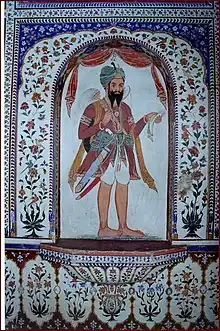
The Mina sect followed Baba Prithi Chand (1558–1618), the eldest son of Guru Ram Das after the younger brother Guru Arjan was officially made the next Guru.[59][60] Called Minas by the orthodox Sikhs, a derogatory term meaning "scoundrels",[60][61] An alternate non-derogatory term for them has been the Miharvan Sikhs, after the son of Prithi Chand. This sect was shunned by orthodox Sikhs, declared by Guru Gobind Singh as one of the five Panj Mel that a Sikh must avoid.[60]
They emerged in a period of religious persecution and inner dispute within the Sikh tradition during the 17th-century on the appropriateness of violence and non-violence in the pursuit of religious freedoms and spiritual matters. According to Hardip Syan and Pritam Singh, Miharvans emphasized more of the non-militant approach of Guru Nanak and earlier Gurus in theological pursuits, while the Guru Hargobind followers pursued the "miri piri" approach and began militarizing the Sikh tradition to resist the Mughal persecution.[62][63] The Minas controlled Amritsar and Harmandir Sahib built under Guru Arjan for much of the 17th-century.[64] After the death of Prithi Chand, his son, Meharban, became the next Mina Guru. After Meharban, his son Harji became the successor. After Hariji, the sect would splinter into different groups.[65]
The Minas faded in the eighteenth century and are now largely extinct.[64][59][66]
Hindalis
_depicting_the_Gurgadi_(guruship_anointment)_ceremony_of_Guru_Ram_Das_with_an_audience_of_regional_Manji_heads%252C_from_Gurdwara_Chaubara_Sahib.jpg.webp)
A lesser Sikh sect contemporary to the Minas was the obscure Hindalis (Gurmukhi: ਹਿੰਦਾਲੀਏ; hidālī'ē), or Niranjanis (Gurmukhi: ਨਿਰੰਜਨੀਏ; nirajanī'ē),[35] who followed Bidhi Chand of Jandiala (Gurmukhi: ਜੰਡਿਆਲਾ ਦੇ ਬਿਧੀ ਚੰਦ; distinct from Bidhi Chand Chhina), son of Hindal (Gurmukhi: ਹਿੰਦਾਲ or ਹੰਦਾਲ),[67] a resident of Amritsar who became a Sikh during Guru Amar Das' reign, who would follow his father's path, becoming a chief official at a Sikh temple in the town of Jandiala Guru in Amritsar. He would lose his congregation after marrying a Muslim woman however, and so would establish a new panth in an effort to undermine Guru Hargobind, propagating his father Hindal to be superior to Guru Nanak, who was relegated to being simply a follower of Kabir.[68]: 178 They would not impact Sikh society the way as the Minas did, leaving little behind besides a janamsakhi tradition and attempts to link their tradition to Bhai Bala, a Sandhu Jatt, as they were a Jatt-led sect.[69] Despite the majority of the Sikh panth being Jatt, the Hindalis did not draw a large following. The Hindalis, compared to the Minas, produced a modest volume of literary contribution. The competing works of the Minas and Hindalis provide insight into early Sikh society and thought.[70]
Ramraiyas
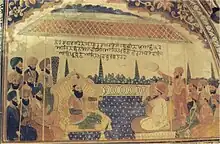
Ram Raiyas were a sect of Sikhism who followed Ram Rai, the eldest son of Guru Har Rai. He was sent by his father as an emissary to the Mughal emperor Aurangzeb in Delhi. Aurangzeb objected to a verse in the Sikh scripture (Asa ki Var) that stated, "the clay from a Musalman's grave is kneaded into potter's lump", considering it an insult to Islam. Ram Rai explained that the text was miscopied and modified it, substituting "Musalman" with "Beiman" (faithless, evil) which Aurangzeb approved.[71][72] The willingness to change a word led Guru Har Rai to bar his son from his presence. Aurangzeb responded by granting Ram Rai a jagir (land grant) in Garhwal region (Uttarakhand). The town later came to be known as Dehradun, after Dehra referring to Ram Rai's shrine.[72] Many Sikhs settled with Ram Rai, they followed Guru Nanak, but orthodox Sikhs have shunned them.[71][73] They were one of the Panj Mel, the five reprobate groups that orthodox Sikhs are expected to shun with contempt. The other four are the Minas, the Masands, the Dhirmalias, the Sir-gums (those Sikhs who accept Amrit baptism but subsequently cut their hair).[61][74] According to census figures, over 82,000 Sikhs and Hindus returned their census forms claiming to be Ramraiyas in the 1891 British Raj census.[66] The sect today is based out of Dehradun.[66]
Dhirmalias
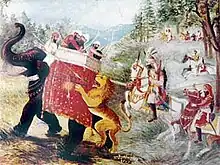
The Dhirmalias were a heretical sect founded by Dhir Mal, the eldest son of Gurditta and grandson of Guru Hargobind.[75][76][77] Dhir Mal is considered a traitor by mainstream Sikhs due to his greed for the guruship, wealth, and power.[78][79] Guru Gobind Singh forbade his Sikhs from having any relation with Dhirmalias.[80][81] The sect was awarded the original manuscript of the Adi Granth, which was prepared by Guru Arjan and his scribe Bhai Gurdas, in 1643.[82] This particular manuscript is known as the Kartarpur Bir.[83] The Sodhis of Kartarpur claim to be their descendents and have in their possession the manuscript.[66] Also, a shrine dedicated to Dhir Mal is located in Kartarpur as well.[66] Vadhbag Singh Sodhi, an 18th-century descendent of the Sikh Gurus, was a prominent figure of the sect.[84] Dhir Mal's great-grandson, Bikram Singh, would later give up connections to the sect and be baptized into the Khalsa order and become a mainstream Sikh.[85]
Nanakpanthi
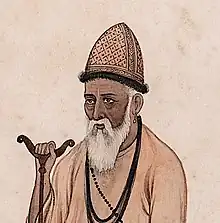
A Nanakpanthi is a follower of the teachings of Guru Nanak, the first guru of Sikhism. The community transcends the boundaries of Sikhism and Hinduism, and was also a reference to the early Sikh community.[86] Most Sindhi Hindu people are Nanakpanthi, and during the 1881 and 1891 censuses, the community could not decide whether to self-identify as Hindu or Sikh.[87] In 1911, Shahpur District (Punjab) reported 12,539 Hindus (20% of the total Hindu population) identifying themselves as Nanakpanthi, in addition to 9,016 Sikhs (22% of the total Sikh population).[88] The institutional focus of Nanakpanthi social life was around a dharamsala, playing the same role before the 20th century as the Gurdwara has played thereafter under Khalsa dominated period.[89] The beliefs and practices of the Nanakpanthis overlapped with those of Sahajdhari and Udasi Sikhs in pre-20th century period, as evidenced by documents dated to that period.[90][91] In 1891 Census of British India, which was the first to categorize Sikhs into sects, 579,000 people identified themselves as "Hindu Nanakpanthi" and another 297,000 as "Sikh Nanakpanthi". The other major Sikh categories were Sikh Kesdhari and Gobind Singhi Sikhs in this census.[92] Many Muslims also consider themselves as Nanakpanthis.
Later Sikh sects (post-1708)
Tat Khalsa
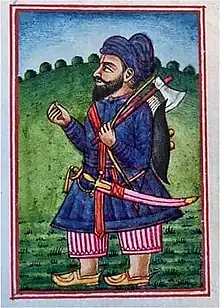
The Tat Khalsa[93] (Gurmukhi: ਤੱਤ ਖਾਲਸਾ, translit. Tata khālasā), also romanised as Tatt Khalsa, known as the Akal Purkhias during the 18th century,[94] was a Sikh faction that arose from the schism following the passing of Guru Gobind Singh in 1708, led by his widow Mata Sundari, opposed to the religious innovations of Banda Singh Bahadur and his followers.[93] It is regarded as the orthodox and orthoprax sect of Sikhism.[95] "Proper Sikhs" are those who have been initiated into the Khalsa order (amritdharis), those who do not cut their hair (keshdhari), those who are slow-adopters (sehajdharis), and even lapsed or apostate Sikhs (patits).[96]
Bandai Khalsa

The Bandais were those who believed Banda Singh Bahadur was the spiritual successor of Guru Gobind Singh and therefore the 11th human Guru.[97] This belief created distance between them and the orthodox Sikhs which were led by Mata Sundari (widow of Guru Gobind Singh), who regarded their belief as heretical.[97] They were excommunicated from mainstream Sikhism by the Tat Khalsa faction in 1721. Only a few exist now in the present-day.[98] The Bandais were noted for changing the Khalsa dress code colours from blue to red, using the greeting and jaikara (war-cry): Fateh Darshan (meaning 'bear witness to the victory'), and were staunch vegetarians.[99][100] The Fateh Darshan battle-cry and greeting was later withdrawn from use by Banda himself due to opposition from orthodox Khalsa and he had not meant to replace the traditional Sikh greetings and jaikaras bestowed upon the Sikhs by the Gurus.[101]
Gulab Raiyas
The Gulab Raiyas, also known as Gulab Rahis, were followers of Gulab Rai, who was the son of Dip Chand, grandson of Suraj Mal, and great-grandson of Guru Hargobind.[26][102] Gulab Rai was baptized into the Khalsa by Guru Gobind Singh himself when the latter was alive.[103] In 1705, during the aftermath of the siege of Anandpur, Guru Gobind Singh sent him and his brother, Shyam Singh, to the state of Nahan, to present an introductory letter to the ruler (who was an ally of the Guru).[104] The Raja of Nahan bestowed Gulab Rai and his brother a village.[104] After, they returned to Anandpur where they set up base after they purchased the locality from the Raja of Bilaspur state.[104] Initially, he rejuvenated the city as a site of Sikhism but eventually Gulab Rai tried to usurp the Sikh guruship for himself.[102][104] He attempted to emulate the Sikh gurus by sitting at the same spot that Guru Gobind Singh used to sit at in Anandpur and accepted gifts from the Sikh congregation while doing so.[104] An Udasi who was instructed to stay behind at Anandpur to look after the Sikh sites, named Gurbakhsh Udasi, severely reprimanded Gulab Rai for these actions and is said to have cursed him to have no progeny.[104] Gulab Rai set-up himself as a Guru in his own rite.[105] Gulab Rai kept baptizing new initiates into his sect with the Charan-Pahul ceremony, which had already been replaced in mainstream Sikhism by Guru Gobind Singh's Khande di Pahul innovation.[105] Gulab Rai conspired with his brother, Shyam Singh.[104] Gulab Rai had four sons but none survived him.[104] Gulab Rai is said to have died of grief.[104] After Gulab Rai's passing, his widowed wife assumed the leadership of the sect.[104] She was succeeded by Surjan Singh, the son of Shyam Singh (brother of Gulab Rai).[104] The sect did not survive long and went extinct in the 18th century.[103] Surjan Singh died in 1815.[104]
Namdharis
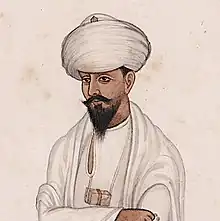
Namdharis, also known as Kuka Sikhs, believe that the line of Sikh Gurus did not end with Guru Gobind Singh, as they claim that he did not die in Nanded but escaped and lived in secret,[106] and that he nominated Balak Singh to be the 11th Guru, a tradition that was continued through the Namdhari leaders.[107][108] They did not believe in any religious ritual other than the repetition of God's name (or nam, for which reason members of the sect are called Namdharis),[109] including the worship of idols, graves, tombs, gods, or goddesses.[110] The Namdharis had more of a social impact due to the fact that they emphasized Khalsa identity and the authority of the Guru Granth Sahib.[111] They call their houses of worship dharamsalas.[112]
Their 12th guru was Ram Singh, who moved the sect's center to Bhaini Sahib (Ludhiana). A Tarkhan or Ramgharia, his rural sect would be composed largely of Ramgharias and poorer Jat Sikhs.[113] They have been strictly vegetarian and a strong opponent of cattle slaughter, and retaliated against Muslims for killing cows in 1872.[114][115] Their leader Ram Singh was arrested by the British and he was exiled to Rangoon, Myanmar. Dozens of Namdharis were arrested by the British and executed without trial in Ludhiana and Ambala.[114] They consider Guru Granth Sahib and Dasam Granth as equally important, and compositions from the Chandi di Var are a part of their daily Nitnem. Like Hindus, they circumambulate the fire (havan) during their weddings, but they differ in that the hymns are those from the Adi Granth.[114][115]
The Namdharis wear homespun white turbans, which they wrap around their heads (sidhi pagri).[106][115] They are called Kuka, which means "crier, shouter", for their ecstatic religious practices during devotional singing. They also meditate, using mala (rosary).[115] Some texts refer to them as Jagiasi or Abhiasi.[114]
Nirankari
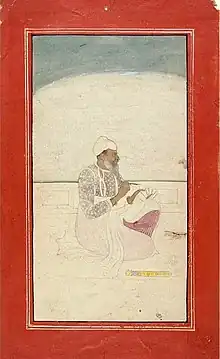
The Nirankari movement was founded by Baba Dyal Das (1783–1855),[116] as a Sikh reform movement in northwestern Punjab around the middle of 19th century, in the later part of Ranjit Singh's reign. Nirankari means "without form", and reflects their belief that God cannot be represented in any form and that true Sikh faith is based on nam simaran.[117][118] Among the earliest Sikh reform movements,[119][116] the Nirankaris condemned the growing idol worship, obeisance to living gurus and influence of Brahmanic ritual that had crept into the Sikh panth.[120] Though not an initiated Khalsa, he urged Sikhs to return to their focus to a formless divine (nirankar) and described himself as a nirankari.[120] Maharaja Ranjit Singh of the Sikh Empire was said to have appreciated his teachings.[119]
Nirankari have opposed any form of ritualism in Sikhism, emphasizing the need to return to the teachings of their founder Guru Nanak. They were the first sect to demand major changes in how Sikh temples are operated, the Sikh ceremonies. They also disagreed with the orthodox Sikhs on only 10 Gurus and the scripture as the living Guru. Nirankaris believe that human guru to interpret the scripture and guide Sikhs is a necessity.[106][117] Nirankaris are indistinguishable from other Sikhs in outward appearance, with both kesdhari ("hair-keeping") and sahajdhari ("slow-adopter") followers; their acceptance of the mainstream Sikh marriage settled the main issue dividing them from the orthodox Sikhs, leaving only their recognition of a continuing line of Gurus from Baba Dyal as the main differentiation.[35]
There are two Nirankari groups, the Asli Nirankaris (meaning "real Nirankaris"), founded by Baba Dyal Singh, and the Nakali Nirankaris (meaning "fake Nirankaris"), a latter heretical splinter group of the original Nirankari movement.[118][121]
The Sant Nirankaris are a small group which splintered from the Nirankaris in the 1940s, and is opposed by orthodox Sikhs and Nirankaris alike.[35] They believe that scripture is open and therefore added works of their leaders into the Guru Granth Sahib. This led to increasingly conflicts with the orthodox Sikhs, with whom the Sant Nirankaris had clashed since the 1950s, with tensions increasing due to some of Gurbachan Singh's religious actions, culminating in the 1978 Sikh-Nirankari clashes and further incidents.[122][123][124][125] In late 1970s, Jarnail Singh Bhindranwale repeatedly denounced their practices. In 1980, the leader of Sant Nirankari tradition, Gurbachan Singh, was assassinated.[123][126]
Sanatani
Sanatan Sikh, a term and formulation coined by Harjot Oberoi,[127] referred to Sikhs who formed a traditionalist faction during the Singh Sabha Movement in 1873.[128] They campaigned for a Dharmic interpretation that accepted a wide range of beliefs drawn from Hinduism.[128] The Amritsar Singh Sabha was led by Khem Singh Bedi, Avtar Singh Vahiria and others. Sanatan Sikhs accept beliefs and practices such as the belief in the teachings of the Vedas, Puranas, and Hindu epics.[128][129][130] They also were tolerant to the use of idols and images of Sikh Gurus as well as other icons within Gurdwaras. Instead of treating scripture as the only guru, Sanatan Sikhs campaigned for acceptability of living gurus to guide those Sikhs who seek one.[129][131] Amid factional rivalry, the influence of the dominant Tat Khalsa ("true Khalsa"),[132] due to the support of the Sikh masses, resulted in the decline of Sanatan Sikhs.[128][129][133] Today, it is a marginalized interpretation of Sikhism.
Nanaksari
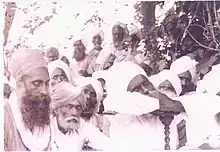
The Nanaksari (or Nanaksar) sect and movement was founded by Nand Singh in Rawalpindi during the latter years of the 19th century.[134][135][136] Most followers of the sect draw from the Ramgarhia Sikh community.[135] The founder claims to have had a vision of Guru Nanak appearing from out of the Guru Granth Sahib while deep in meditation.[137] They are described as a conservative group who approach the Sikh scriptures with a literalist interpretation.[138] The movement has been categorized as semi-orthodox but not outright heretical.[121] The sect is headed by a spiritual lingeage of sants (saints) and is prominent in rural Punjab.[139] Followers of the sect are strict vegetarians who reject and reinterpret historical anecdotes of the Sikh Gurus hunting animals.[140] After Nand Singh, the sect was headed by his disciple, Ishar Singh.[137]
Akhand Kirtani Jatha

The Akhand Kirtani sect, officially known as the Akhand Kirtani Jatha (AKJ), is a sect founded by Randhir Singh and originated in the late 19th century as an anti-colonial movement.[141] The leadership of the sect primarily draws from the Khatri caste even though the founder, Randhir Singh, was a Jat.[142] They are regarded as a semi-orthodox sect of Sikhism, as they maintain their own rehat (code of conduct).[121] Their interpretation of the Five Ks differ from mainstream Sikhs, they believe that what most Sikhs call Kesh refers to Keski (headpiece) rather than actual, unshorn hair as they believe the Five Ks cannot refer to parts of the physical body.[143] They place heavy importance on the recital of gurbani (Sikh hymns), performing Akhand Paths and Sahaj Paths (non-stop recitation of the Sikh scriptures), and are renowned for their unique way of performing kirtan (devotional Sikh music).[144] Their method of kirtan differs from other Sikh groups as they place strong emphasis on repetition, breathing techniques, and fervour whilst using comparatively recent instruments like the tabla and vaaja (harmonium) rather than traditional Sikh instruments during their rainsbai all-night long kirtan sessions.[145] The group played an important role in 1978 Sikh–Nirankari clash, with the Babbar Khalsa being a breakaway group from the Akhand Kirtanis.[146]
Radha Soami
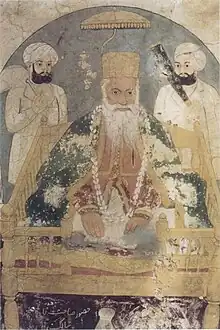
The meaning of Radha Soami is 'lord of the soul'. This movement was started by Shiv Dayal Singh (also known as Soamiji) in 1861, follower of Guru Nanak and Tulsi sahib of Hathras. The Radhasoamis are like sect of Sikhism, as it does have connections with Sikhism, and the teachings of their founder were based, in part, on those of the founder of Sikhism, Guru Nanak and those who followed. They consider themselves a separate religion. Many recite verses from the Adi Granth during their worship, though few would call themselves a Sikh sect, as there are no ties between it and orthodox Sikh organizations, and most Sikhs would also regard the idea of Radhasoami as separate from their own.[147] However, they are also different from the Sikhs because they have present-day Gurus, and do not follow the Khalsa dress code.
The Radhasoamis are a religious fellowship that accepts saints and living gurus from anywhere.[147][148] According to its founder, "image worship, pilgrimages or idol worship" is a "waste of time," "ceremonies and religious rituals are a conceit," and all traditional religious technicians, "the Rishis, Yogis, Brahmans, and Sannyasins," have "failed," while its leaders, while believing in karma, have been emphatic in rejecting other often cardinal Hindu beliefs and in their suspicion of institutions, leading a 19th-century leader to assert its independent basis from Hinduism "or any other religion," often choosing to avoid the word "religion" altogether, with a leader describing it as "no religion at all," but an amalgamation of "the teachings of ... all saints of the world." It has attracted a large number of Dalits, and in the diaspora have attracted may members of other ethnic groups for which the satsang is conducted in English.[147]
Like the writings of Sikh gurus, Shiv Dayal used the epithet satnam for the divine.[149] The Radhasoamis do not install the any other scriptures in their sanctum. Instead, the guru sits in the sanctum while conducting the satsang and they listen to explanation of sayings of various saints, from the Adi Granth or the living guru, as well as sing hymns together.[148] The Radha Soamis are strict vegetarians like some Sikhs. They are active in charitable work such as providing free medical services and help to the needy.[148]
Ridváni
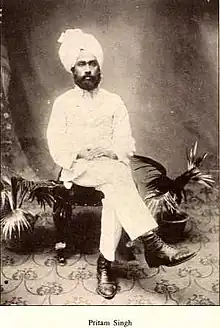
The Ridváni Sikh Fellowship was founded in Mumbai in the year 1908 by Prof. Pritam Singh,[150][151] who was the first Sikh to profess faith in Baháʼu'lláh, founder of the Baháʼí Faith. The name Ridváni is derived from the Baha'i festival of Ridván. The Ridvanis view the Báb and Baháʼu'lláh as the Mahdi and the Kalki avatar respectively, as the Dasam Granth notes they had yet to arrive by the time of Guru Gobind Singh. Ridvánis keep the panj kakkars, adhere to the Rehat Maryada, and read the Guru Granth Sahib, while also following the commands of the Kitáb-i-Aqdas including Baha'i prayer and meditation, giving 19% of one's disposable income in kind, and social ordinances like burial customs. Ridvani Sikhs celebrate all traditional Sikh and Baha'i holidays, as well as astrological holidays such as Sankranti, Muslim holidays such as Qadr Night and Eid al-Adha, and the Christian holidays of Fasika, Pentecost and Halloween. While most Ridvánis live in India, a significant diaspora exists in North America and historically in Baghdad.
3HO
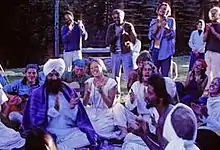
The 3HO sect (abbreviation for 'Healthy, Happy, Holy Organization') is a western group that emerged in 1971, founded by Harbhajan Singh, popularly known as Yogi Bhajan. It requires both men and women to wear turbans, adopt the surname Khalsa, and wear all-white attire. They also call themselves the "Sikh Dharma movement" and "Khalsa Dharma movement" and are often called Gora (meaning "white person", though not all White Sikhs follow 3HO) Sikhs and Bhajanists[152] by the mainstream adherents of Sikhism. Their name 3HO, stands for Healthy Happy Holy Organization. This Sikh sect emphasizes meditation and Yoga. The sect started and grew a number of international business brands such as Yogi Tea. 3HO's relations with the orthodox Khalsa are quite mixed. The 3HO sect has a strict rahit, the code of conduct expectation.[9][11] Another characteristic of the sect is that they allow baptized Sikh women to form the Panj Pyare.[153] The sect numbered around 5,000 in the early 1990s.[154]
Kala Afghana [lower-alpha 2]
A term used to refer to Gurbakhsh Singh, a resident of the locality of Kala Afghana, and his followers.[155] The group challenged many long-standing beliefs and practices of Sikhism, creating enemies with traditionalist and conservative sectors of Sikhs as a result.[155] They claimed to be purists of the Guru Granth Sahib and rejected many aspects of contemporary Sikhism as being "Brahminical" innovations.[155] They are staunchly against the Dasam Granth.[156] Its founder was ex-communicated by the Akal Takht in 2003.[155]
Split traditions
This section deals with split traditions or former Sikh sects which no-longer self-identify as such. Two contemporary Indian religions, Ravidassia and Bhaniara Dera, began as sects of the Sikh religion, but no longer identify as part of Sikhism. In both cases, their separation from Sikhism was marked by the adoption of a new religious scripture to replace the Guru Granth Sahib.
Gulabdasia
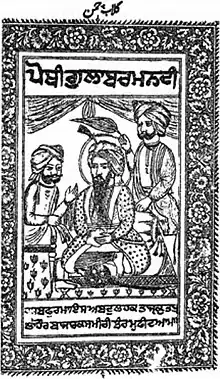
The Gulabdasia sect (or dera) was founded in the 19th century by Gulab Das (born as Gulab Singh[157]), whom was born in 1809 into a Jat Sikh family to a father named Hamira in the village of Rataul in Tarn Taran district.[158][104] He served in the Sikh Khalsa Army as a trooper during the time of Maharaja Sher Singh.[104] Gulab Das learnt Vedantic knowledge from Nirmalas.[103] When the Sikh Empire was deposed, he became a disciple of an Udasi saint named Pritam Das.[104] His published works include Updes Bilas and Pothi Gulab Chaman Di, these works lay out their unique ideology and practices of the sect.[104] The sect promoted an epicurean lifestyle and rejected ritualism.[159] They did not believe in pilgramages, religious ceremonies, or reverence of proclaimed holy men.[103] They believed that mankind and the divine were of the same essence, and that mankind would eventually be absorbed into the divine.[104] They believed only that pleasure and sensual gratification was worth aspiring towards.[104] The followers of the sect wore expensive clothing and lived a life of unrestrained indulgence in all different kinds of ways.[104] They detested lies.[104] Many wore white garbs, others dressed as Udasis, yet more dressed up like Nirmalas, and some liked to be clean-shaven.[104] Piro Preman, an ex-Muslim and first female poet of the Punjabi-language, was associated with the sect.[160][161] The sect was unorthodox, influenced by the Bhakti movement and Sufism in regards to devotion, and criticized caste divisions and discrimination occurring at the time in society.[162] Most of its followers drew from the Dalit community. The sect was headquartered in Chathianwala, near Lahore, and was established sometime during the reign of Maharaja Ranjit Singh during the Sikh Empire.[163] Another source lists its pre-partition headquarters as the village Chatthe, near Kasur.[104] It was part of the North Indian panth and sant mat movements at the time.[163] Guru Gulab Das died in 1873 and Piro Preman inherited the sainthood.[163][164] Giani Ditt Singh was associated with the sect in his early life as a preacher, where he was known as Sant Ditta Ram, before he was adopted into mainstream Sikhism.[165][103] Jawahir Singh Kapur also was associated with this sect in his early years.[103] The sect never had a large amount of followers and its numbers dwindled when Patiala State banned their entry due to their sexually expressive and liberal acts, which went against the mainstream social norm.[104] The Gulabdasias numbered 763 in the 1891 census.[104] The sect was most prevalent in the late 19th century but is likely extinct at present.[103]
Ravidassia

The Ravidasi Panth used to be a part of Sikhism. In 2009, the sect left Sikhism and gained recognition as a separate tradition.[166] It is based on the teachings of the 14th century Indian guru Ravidas, revered as a satguru.[166] The movement had attracted dalits (formerly marginalised), and they felt that they were a victim of social discrimination and violence from government Sikhs.[167][168][169]
Historically, Ravidassia represented a range of beliefs in the Indian subcontinent, with some devotees of Ravidass counting themselves as Ravidassia Sikhs, but first formed in the early 20th-century in colonial British India.[166] The Ravidassia community began to take on more cohesion following 1947, and the establishment of successful Ravidassia communities in the diaspora.[170]
Ravidassias, states Ronki Ram, accept contemporary living sants of Ravidass Deras as Guru whereas the Sikhs do not.[169] In 2009, Many of the government people went to attack by pretending to be Sikhs violently attacked the living guru, his deputy and followers at a Ravidassia gurdwara (temple) in Vienna.[167] This assassination attempt injured many and killed the deputy Ramanand Dass. This triggered the Ravidasi Sikhs to leave Sikhism and become an independent religion fully separated from Sikhism.[169][171]
Prior to their break from Sikhism, the Dera Bhallan revered and recited the Guru Granth Sahib of Sikhism in Dera Bhallan.[172] However, following their split from mainstream Sikhism, the Dera Bhallan compiled their own holy book based exclusively on Ravidas's teachings, the Amritbani Guru Ravidass Ji, and these Dera Bhallan Ravidassia temples now use this book in place of the Guru Granth Sahib.[172][168][173]
Bhaniara Dera
A breakaway sect founded by Piara Singh Bhaniara, who claimed to be an incarnation of Guru Gobind Singh, in the 1980s based in Dhamiana village in Ropar. Most of its followers drew from the Dalit community, known as Mazhabi Sikhs. In 2001, a scripture was published by the group named Bhavsagar Samunder Amrit Vani Granth (commonly shortened to simply Bhavsagar Granth), which was later banned by the Government of Punjab for hurting the religious feelings of Sikhs.[174][175][176][177]
Notes
- Sometimes equated to and used interchangabely with the Damdami Taksal and Amritsari Taksal of Sato Ki Gali
- Often grouped with wider "Missionary" theology, representative of reformist scholasticism
See also
References
- Hardip Singh Syan (2014). Pashaura Singh and Louis E. Fenech (ed.). The Oxford Handbook of Sikh Studies. Oxford University Press. pp. 170–180. ISBN 978-0-19-969930-8.
- Opinderjit Kaur Takhar (2014). Pashaura Singh and Louis E. Fenech (ed.). The Oxford Handbook of Sikh Studies. Oxford University Press. pp. 350–359. ISBN 978-0-19-969930-8.
- Harjot Oberoi (1994). The Construction of Religious Boundaries: Culture, Identity, and Diversity in the Sikh Tradition. University of Chicago Press. pp. 24–25. ISBN 978-0-226-61592-9.
- Rohani, M., & AliMardi, M. M. (2012). Sikh Sects. Journal of Seven Heavens, 14(54), 27-48. URL: https://haftasman.urd.ac.ir/article_66832.html?lang=en. "Sikhism consists of three major denominations; these sects in the order of importance are: Khālsā, Nāmdhari, Nirankāri. They take different positions on the nature of Guru or spiritual teacher. Khālsā sect - to which the majority of Sikhs adhere - itself consists of three groups, which become distinguished from each other by their certain kind of clothes, life style, and some religious principles. These three groups are called Nihang (Akāli), Nirmalā, and Sewāpanthi. Furthermore, in some scriptures, references have been made to one of the Sikh sects called Udāsi, which was established by Guru Nanak's oldest son, Sri Chand. By considering the beliefs and religious ceremonies, this sect is by no means similar to the mainstream Sikhism, because it neither acknowledges the series of ten Gurus, nor is Monotheistic. Nevertheless, since Udāsi identifies itself as the follower of Guru Nanak and has played an important role in Sikh history, it would be regarded as one of the Sikh sects in this paper."
- Louis E. Fenech; W. H. McLeod (2014). Historical Dictionary of Sikhism. Rowman & Littlefield Publishers. pp. 260–261. ISBN 978-1-4422-3601-1.
- Louis E. Fenech; W. H. McLeod (2014). Historical Dictionary of Sikhism. Rowman & Littlefield. pp. 151, 273. ISBN 978-1-4422-3601-1.
- Pashaura Singh; Louis E. Fenech (2014). The Oxford Handbook of Sikh Studies. Oxford University Press. pp. 28–29, 73–76. ISBN 978-0-19-969930-8.
- Arvind-Pal Singh Mandair (2013). Sikhism: A Guide for the Perplexed. Bloomsburg Academic. pp. 85–86. ISBN 978-1-4411-0231-7.
- Sects in Sikhism, Encyclopedia Britannica
- Page 141, The Culture of India, Kathleen Kuiper, The Rosen Publishing Group
- Kalsi, Sewa Singh (2005). Sikhism. Religions of the World. Philadelphia: Chelsea House Publishers. pp. 9–14. ISBN 0-7910-8098-6.
- Verne Dusenbery (2014). Pashaura Singh and Louis E. Fenech (ed.). The Oxford Handbook of Sikh Studies. Oxford University Press. pp. 560–570. ISBN 978-0-19-969930-8.
- Mooney, Nicola (2012). "Reading Weber Among the Sikhs: Asceticism and Capitalism in the 3Ho/Sikh Dharma". Sikh Formations. Taylor & Francis. 8 (3): 417–436. doi:10.1080/17448727.2012.745305. ISSN 1744-8727. S2CID 145775040.
- Harjot Oberoi (1994). The Construction of Religious Boundaries: Culture, Identity, and Diversity in the Sikh Tradition. University of Chicago Press. pp. 78–80. ISBN 978-0-226-61592-9.
- Pashaura Singh; Louis E. Fenech (2014). The Oxford Handbook of Sikh Studies. Oxford University Press. pp. 375–377. ISBN 978-0-19-969930-8.
- Oberoi 1994, p. 78.
- John Stratton Hawley; Gurinder Singh Mann (1993). Studying the Sikhs: Issues for North America. SUNY Press. p. 182. ISBN 978-0-7914-1426-2.
- Singh & Fenech 2014, p. 376.
- Pashaura Singh; Louis E. Fenech (2014). The Oxford Handbook of Sikh Studies. OUP Oxford. pp. 375–378. ISBN 978-0-19-100412-4.
- Deol, Harnik (2000). Religion and Nationalism in India: The Case of the Punjab (Routledge Studies in the Modern History of Asia) (1st ed.). New York City, U.S.A.: Routledge. pp. 76–78. ISBN 978-0415201087.
- Agnihotri, Dr. V.K. (1988). Indian History with Objective Questions and Historical Maps (26th ed.). New Delhi, India: Allied Publishers. p. C-171. ISBN 9788184245684.
- Singh & Fenech 2014, p. 31.
- Pashaura Singh; Louis E. Fenech (2014). The Oxford Handbook of Sikh Studies. Oxford University Press. pp. 542–543. ISBN 978-0-19-100412-4.
- Tanweer Fazal (1 August 2014). "Nation-state" and Minority Rights in India: Comparative Perspectives on Muslim and Sikh Identities. Routledge. p. 113. ISBN 978-1-317-75179-3.
- Singh, Harbans (2011). The Encyclopedia of Sikhism. Vol. 2: E-L (3rd ed.). Punjabi University, Patiala. p. 318.
- Singh, Bhupinder (October–December 2020). "Nanakpanthis". Abstracts of Sikh Studies. Institute of Sikh Studies. XXII (4).
- Singh, Bhupender (2022). Baba Nanak Shah Fakir. Blue Rose Publishers. pp. 14–15. ISBN 9789357046602.
- Fenech, Louis E.; McLeod, W. H. (2014). Historical Dictionary of Sikhism. Historical Dictionaries of Religions, Philosophies, and Movements Series (3rd ed.). Rowman & Littlefield. p. 161. ISBN 9781442236011.
- Malkani, Dada Kewalram Ratanmal. The Sindh Story: A Great Account on Sindh. Sani Hussain Panhwar. p. 123.
Guru Nanak's two sons Baba Lakhmichand and Baba Srichand, gave rise to the Jagiasu and Udasi schools of preachers. They also established many temples. Chief of them was Bawa Gurpat Saheb, the twelfth-generation descendant of Guru Nanak. He played a notable role in Sindhi society. No wonder the Sindhis are very familiar with Sikh scriptures. Today even important Sindhi Muslim leaders such as G.M. Syed feel that the teachings of Guru Nanak would be good for all Sindhis and Punjabis.
- Jotwani, Motilal Wadhumal (1979). Sindhi Literature and Society. Rajesh Publications. pp. 65–66.
- Nirmala: Sikhism, Encyclopaedia Britannica
- Sulakhan Singh (2001). "Heterodoxy in Sikhism: An Exposition of Some Sectarian Developments". In Parm Bakhshish Singh (ed.). Punjab History Conference, Thirty-second Session, March 17-19, 2000: Proceedings. Punjabi University. pp. 77–78. ISBN 978-81-7380-722-0.
- Purnima Dhavan (2011). When Sparrows Became Hawks: The Making of the Sikh Warrior Tradition, 1699-1799. Oxford University Press. pp. 221 note 3. ISBN 978-0-19-975655-1.
- Nirmala, The Encyclopedia of Sikhism Volume III, Punjabi University, Patiala, pages 236–237
- W. H. McLeod (2005). Historical Dictionary of Sikhism. Scarecrow Press. pp. 148–149. ISBN 978-0-8108-5088-0.
- W. Owen Cole; Piara Singh Sambhi (2005). A Popular Dictionary of Sikhism: Sikh Religion and Philosophy. Routledge. p. 62. ISBN 978-1-135-79760-7.
- Pashaura Singh; Louis E. Fenech (2014). The Oxford Handbook of Sikh Studies. Oxford University Press. pp. 87–88. ISBN 978-0-19-100411-7.
- Nityananda Misra (2019). Kumbha: The Traditionally Modern Mela. Bloomsbury Academic. pp. 79–80. ISBN 978-93-88414-12-8.
- Pashaura Singh; Louis E. Fenech (2014). The Oxford Handbook of Sikh Studies. OUP Oxford. pp. 377–378. ISBN 978-0-19-100412-4.
- Horstmann, Monika. Patronage and popularisation, pilgrimage and procession: channels of transcultural translation and transmission in early modern South Asia; papers in honour of Monika Horstmann. Vol. 58. Otto Harrassowitz Verlag, 2009.
- Zurlo, Gina A. (2022). "Glossary". Global Christianity : a guide to the world's largest religion from Afghanistan to Zimbabwe. Grand Rapids, Michigan. p. 325. ISBN 978-0-310-11361-4. OCLC 1303558842.
Sikhs: Followers of the Sikhism, founded by Guru Nanak in the 15th century in the Punjab region of the Indian subcontinent. Traditions include Akali, Khalsa, Nanapanthi, Nirmali, Sewapanthi, and Udasi.
{{cite book}}: CS1 maint: location missing publisher (link) - Singh, Jay. Teach Me about Sikhism. Trafford Publishing, 2002.
- Mahal, Ramandeep. "Bhai Kanhaiya ji: A Humanitarian Soul."
- Shriniwas, Geeta. "sevapanthi sampradaya itihash aur vikas."
- ਅਕਾਲੀ - akālī - अकाली ਵਿ- ਅਕਾਲ ਨਾਲ ਹੈ ਜਿਸ ਦਾ ਸੰਬੰਧ। ੨. ਸੰਗ੍ਯਾ- ਅਕਾਲ ਉਪਾਸਕ. ਵਾਹਗੁਰੂ ਜੀ ਕਾ ਖ਼ਾਲਸਾ.#ਕਮਲ ਜ੍ਯੋਂ ਮਾਯਾ ਜਲ ਵਿੱਚ ਹੈ ਅਲੇਪ ਸਦਾ#ਸਭ ਦਾ ਸਨੇਹੀ ਚਾਲ ਸਭ ਤੋਂ ਨਿਰਾਲੀ ਹੈ,#ਕਰਕੇ ਕਮਾਈ ਖਾਵੇ ਮੰਗਣਾ ਹਰਾਮ ਜਾਣੇ#ਭਾਣੇ ਵਿੱਚ ਵਿਪਦਾ ਨੂੰ ਮੰਨੋ ਖ਼ੁਸ਼ਹਾਲੀ ਹੈ,#ਸ੍ਵਾਰਥ ਤੋਂ ਬਿਨਾ ਗੁਰੁਦ੍ਵਾਰਿਆਂ ਦਾ ਚੌਕੀਦਾਰ#ਧਰਮ ਦੇ ਜੰਗ ਲਈ ਚੜ੍ਹੇ ਮੁਖ ਲਾਲੀ ਹੈ,#ਪੂਜੇ ਨੇ ਅਕਾਲ ਬਿਨਾ ਹੋਰ ਕੋਈ ਦੇਵੀ ਦੇਵ#ਸਿੱਖ ਦਸ਼ਮੇਸ਼ ਦਾ ਸੋ ਕਹੀਏ 'ਅਕਾਲੀ' ਹੈ.#੩. ਖ਼ਾਸ ਕਰਕੇ ਇਹ ਸ਼ਬਦ ਨਿਹੰਗ ਸਿੰਘਾਂ ਲਈ ਭੀ ਵਰਤਿਆ ਜਾਂਦਾ ਹੈ. ਦੇਖੋ, ਨਿਹੰਗ.
- Singh, Satnam. "Worshipping the sword: The practice of śāstar pūjā in the Sikh warrior tradition." Objects of Worship in South Asian Religions. Routledge, 2014. 182-199.
- Singh, Pashaura; Fenech, Louis E. (March 2014). The Oxford Handbook of Sikh Studies. OUP Oxford. ISBN 978-0-19-969930-8.
- Freedom, We Need (2007-11-30). "Frontline Punjabi Youth: What is Shaheedi Degh?". Frontline Punjabi Youth. Retrieved 2023-02-21.
- "Jhatka". Shiromani Panth Akali Budha Dal. 2017-11-19. Retrieved 2023-02-21.
- "Historical Granths-Controversy?". Shiromani Panth Akali Budha Dal. 2021-01-20. Retrieved 2023-02-21.
- Singh, Nirbhai. Philosophy of Sikhism: Reality and its manifestations. Atlantic Publishers & Distri, 1990.
- Judge, Paramjit Singh. "Taksals, Akharas, and Nihang Deras." The Oxford Handbook of Sikh Studies (2014): 372-82.
- Dhillon, Dalbir (1988). Sikhism Origin and Development. Atlantic Publishers & Distri. p. 152.
- Re-imagining South Asian religions : essays in honour of professors Harold G. Coward and Ronald W. Neufeldt. Pashaura Singh, Michael Hawley, Harold G. Coward, Ronald W. Neufeldt. Leiden: Brill. 2013. ISBN 978-90-04-24237-1. OCLC 833766094.
{{cite book}}: CS1 maint: others (link) - "Sanatan Sikhi - Sikh Sampardas". www.sarbloh.info. Retrieved 2023-02-24.
- Singh, Pashaura (2003). The Guru Granth Sahib: Canon, Meaning and Authority. Oxford University Press. ISBN 9780199087730.
- Mahmood, Cynthia Keppley (1997). Fighting for faith and nation : dialogues with Sikh militants. Philadelphia: University of Pennsylvania Press. ISBN 0-585-12702-6. OCLC 44966032.
- Tambiah, Stanley Jeyaraja (1996). Leveling crowds : ethnonationalist conflicts and collective violence in South Asia. Berkeley: University of California Press. ISBN 978-0-520-91819-1. OCLC 44961174.
- H. S. Singha (2000). The Encyclopedia of Sikhism (over 1000 Entries). Hemkunt Press. p. 165. ISBN 978-81-7010-301-1.
- Winand M. Callewaert; Rupert Snell (1994). According to Tradition: Hagiographical Writing in India. Otto Harrassowitz Verlag. pp. 23–24. ISBN 978-3-447-03524-8.
- Arvind-Pal S. Mandair; Christopher Shackle; Gurharpal Singh (2013). Sikh Religion, Culture and Ethnicity. Taylor & Francis. pp. 36–37. ISBN 978-1-136-84634-2.
- Singh, Pritam (2015-01-14). "Review: Sikh militancy in the seventeenth century: religious violence in the Moghul and early modern India, by Hardip Singh Syan". South Asian History and Culture. Taylor & Francis. 6 (2): 307–310. doi:10.1080/19472498.2014.999446. S2CID 143447914.
- Syan, Hardip Singh (2011). "Early Sikh Historiography". Sikh Formations. Taylor & Francis. 7 (2): 145–160. doi:10.1080/17448727.2011.593297. S2CID 142930089.
- W. H. McLeod (2005). Historical Dictionary of Sikhism. Scarecrow. pp. 130–131. ISBN 978-0-8108-5088-0.
- Singh, Dalip (1992). Guru Gobind Singh and Khalsa Discipline (1st ed.). Amritsar: Singh Bros. p. 70. ISBN 81-7205-071-2. OCLC 28583123.
- "Minas, Masands, Dhir Malias, Ram Raiyas". Division of Religion and Philosophy - University of Cumbria (www.philtar.ac.uk). Retrieved 2023-03-30.
Adherents: Minas and Masands are now largely extinct. Dhir Malias have descendants to this day (the Sodhis of Kartarpur), and there are Ram Raiyas in Dehra Dun. In the 1891 census 52,317 Hindus and 30,396 Sikhs returned themselves as 'Ram Raia' . (Census of India, 1891, Vol.XX and Vol.XXI, The Punjab and its Feudatories, by E.D. Maclagan, Part II and III, Calcutta, 1892, pp.826-9 and pp.572-3.) However there are no contemporary official numbers, (see also the note at the end of the Explanatory Introduction).
Headquarters/ Main Centre: The descendants of Dhir Mal claim to have a copy of the original Adi Granth held in Kartarpur, and there is a shrine there called Baba Dhir Mal. Ram Raiyas have their centre in Dehra Dun. - "ਹਿੰਦਾਲ (ਹੰਦਾਲ), ਭਾਈ - Encyclopedia of Sikhism". Punjabipedia.org (in Punjabi). Publication Bureau of the Punjabi University Patiala. Retrieved 2022-08-20.
- Syan, Hardip S. (2014). "Sectarian Works". In Singh, Pashaura; Fenech, Louis E. (eds.). The Oxford Handbook of Sikh Studies. Oxford University Press. pp. 170–179. ISBN 978-0-19-969930-8.
- Syan 2014, p. 178.
- Syan 2014, p. 170.
- Ram Rai, Encyclopedia of Sikhism, Editor in Chief: Harbans Singh, Punjab University
- Louis E. Fenech; W. H. McLeod (2014). Historical Dictionary of Sikhism. Rowman & Littlefield. pp. 260–261. ISBN 978-1-4422-3601-1.
- Rām Rāiyā, Encyclopaedia Britannica
- SS Kohli (1993). The Sikh and Sikhism. Atlantic Publishers. pp. 2–3.
- "Dhir Mal | Sikh rebel leader | Britannica". www.britannica.com. Retrieved 2023-03-30.
The older son of Gurditta, Dhir Mal, was rejected because, from his seat in Jalandhar district, he had formed an alliance with Emperor Shāh Jahān. This meant that the younger son of Gurditta, Har Rai, would become the seventh Guru. But Dhir Mal continued to make trouble for the orthodox…
- Singh, Khushwant (1959). The Sikhs Today: Their Religion, History, Culture, Customs, and Way of Life. Orient Longmans. p. 14.
- Suda, Jyoti Prasad (1978). Religions in India: A Study of Their Essential Unity. Sterling. p. 265.
- Macauliffe, Max Arthur (1909). The Sikh Religion: Its Gurus, Sacred Writings and Authors, Volumes 3-4. Vol. 3–4. Clarendon Press. p. 213.
Dhir Mal and his mother Natti were the only members of the Guru's family who did not accompany him on his journey to Kiratpur. In the first place, Dhir Mal had turned traitor, and was ashamed to show his face to the Guru and his Sikhs. In the second place, he thought that, if he remained behind, he could take possession of all the Guru's-property, including the Granth Sahib. It will be remembered that Bidhi Chand had begun to make a copy of the sacred book. He told Dhir Mal that he had copied it as far as the Bilawal Rag, or more than one half of the whole, and, if he might take the Granth Sahib with him, he would soon finish copying the remainder. Dhir Mal replied, 'Go to Kiratpur; I will search the Guru's house for the Granth Sahib, and if I find it, I will send it to thee.' When Bidi Chand overtook the Guru, he told him of Dhir Mal's continued contumacy. The Guru laughingly said, 'Kartarpur was founded by his ancestors. That is why he will not leave it. He desires to improve it, and hence his remaining there. It was improper for him to break with his father and grandfather and to ally himself with the Muhammadans, but he is an incarnation of Prithia and means to establish a sect of his own. Let the Granth Sahib remain with him. When the Sikhs feel devotion, they will deprive him of it.
- Greenlees, Duncan (1960). The Gospel of the Guru-Granth Sahib. World gospel series. Vol. 8. Theosophical Publishing House. pp. lxxxvi (86).
Dhirmal, the Guru's grandson, son of Gurditta, had turned traitor before the last battle and now refused to go humbly to receive the Guruship from Har Gobind's hand ...
- Geaves, Ron (2007). Saivism in the diaspora : contemporary forms of Skanda worship. London: Equinox Pub. p. 158. ISBN 978-1-84553-234-5. OCLC 67840214.
- Nayar, Kamala Elizabeth (2020). "Notes". The Sikh View on Happiness: Guru Arjan's Sukhmani. Jaswinder Singh Sandhu. London: Bloomsbury Publishing Plc. p. 213. ISBN 978-1-350-13988-6. OCLC 1140790571.
93 - According to tradition, when Guru Gobind Singh initiated the Khalsa, he forbade members of the Sikh Panth to interact with the Minas, as also with the followers of the Dhirmalia sect founded by Dhir Mal (grandson of Guru Hargobind) and the ...
- Singh, Pashaura (2006). Life and Work of Guru Arjan: History, Memory, and Biography in the Sikh Tradition. Oxford University Press. ISBN 9780199087808.
This granth was given to Dhir Mal to create a parallel seat of authority at Kartarpur against Guru Hargobind in 1643.
- Bakhshi, Surinder (2008). Sikhs in the Diaspora: A Modern Guide to Practice of the Sikh Faith: A Knowledge Compendium for the Global Age (Special Gurtagaddi ed.). Birmingham, UK. pp. 85–86. ISBN 9780956072801. OCLC 1311132507.
The original Granth, still extant today, had a chequered history. Dhir Mal, the eldest grandson of the sixth Guru, Hargobind Sahib, angered at not being offered Gurtagaddi, Guruship, of which he thought he was the rightful heir as the first-born son, took possession of it in 1634. It remained with his family for about a hundred years when Maharaja Ranjit Singh, the Sikh ruler of Punjab, forcibly acquired it and installed it in Lahore, his capital. On the collapse of the Sikh empire, the British rulers returned the Bir to the 'owners' who lived in Kartarpur, a town founded by the sixth Guru in Punjab. The Granth is known as the Kartarpur Bir. The Sodhi clan, descendants of Guru Hargobind, have preserved the Kartarpur Bir with its original gold stand and display it once a month for worship.
{{cite book}}: CS1 maint: location missing publisher (link) - Health and religious rituals in South Asia : disease, possession, and healing. Fabrizio M. Ferrari. Routledge. 2011. pp. 56–57. ISBN 9781136846298. OCLC 739388185.
{{cite book}}: CS1 maint: others (link) - Singh, Trilochan (2001). The Turban and the Sword of the Sikhs: Essence of Sikhism: History and Exposition of Sikh Baptism, Sikh Symbols, and Moral Code of the Sikhs, Rehitnāmās (2nd rev. and enl. ed.). Amritsar: B. Chattar Singh Jiwan Singh. pp. 193, 426. ISBN 81-7601-491-5. OCLC 51086435.
- Dr. Balwant Singh Dhillon, Guru Nanak Dev University. "The Doctrine of Guru-Panth, Origin and its Characteristic Features" (PDF). globalsikhstudies.net. Retrieved 2015-12-30.
- Empires of the Indus: The Story of a River - Alice Albinia ISBN 978-1-84854-786-5
- A Glossary of the Tribes and Castes of the Punjab and North-West Frontier Province, Vol. 1
- Michael Hawley (2014). Pashaura Singh and Louis E. Fenech (ed.). The Oxford Handbook of Sikh Studies. Oxford University Press. pp. 317–320. ISBN 978-0-19-969930-8.
- Harjot Oberoi (1994). The Construction of Religious Boundaries: Culture, Identity, and Diversity in the Sikh Tradition. University of Chicago Press. pp. 71–80. ISBN 978-0-226-61592-9.
- W. H. McLeod (1999). Sikhs and Sikhism. Oxford University Press. pp. 7–11. ISBN 978-0-19-564745-7.
- Giorgio Shani (2007). Sikh Nationalism and Identity in a Global Age. Routledge. p. 206. ISBN 978-1-134-10188-7.
- Singh, Sudarshan (1997). Siṅgh, Harbans (ed.). Tatt Ḵẖālsā (3rd ed.). Patiala, Punjab, India: Punjab University, Patiala, 2011. pp. 326–327. ISBN 9788173803499.
- Grewal, J. S. (2019). Guru Gobind Singh (1666-1708) : master of the white hawk (1st ed.). New Delhi, India. ISBN 978-0-19-949494-1. OCLC 1121651952.
{{cite book}}: CS1 maint: location missing publisher (link) - Robinson, Catherine Anne. "Raj Karega Khalsa (the Khalsa shall reign): the legacy of Tat Khalsa in portrayals of the Khalsa, the impact on Sikh studies and implications for Sikhism in education." Religions of South Asia 1.1 (2007): 65-80.
- Nesbitt, Eleanor M. (2016). Sikhism : a very short introduction (2nd ed.). Oxford, United Kingdom. p. 82. ISBN 978-0-19-874557-0. OCLC 919186894.
Many Sikhs are unaware of the dedication of the Tat Khalsa and the Akalis to establishing a strong, purified Sikhism, and know little of the competing reform movements. But they are acutely aware of different degrees of commitment to Sikhi. In conversation 'proper Sikhs' emerge as a sub-group of Sikhs. 'Proper Sikhs' are amritdhari (initiated members of the Khalsa) or at the very least kesdhari (a term for those whose hair, including of course moustache and beard, has not been cut or shaved). Sikhs, more generally, include people referred to more technically as sahijdhari and patit. Sahijdhari is explained as 'slow adopter', a term applied to anyone who identifies as Sikh but who is not kesdhari and does not observe the Khalsa discipline. Patit (literally, lapsed'), denotes a Khalsa Sikh who has failed to observe some or all of the codes of discipline.
{{cite book}}: CS1 maint: location missing publisher (link) - Sikh history from Persian sources : translations of major texts. J. S. Grewal, Irfan Habib, Indian History Congress. Session. New Delhi: Tulika. 2001. p. 26. ISBN 81-85229-17-1. OCLC 47024480.
Bhangu clearly states that Banda started a new panth, which alienated him from the staunch followers of Guru Gobind Singh. Chhibber states that many people regarded Banda Bahadur as the eleventh Patshahi (Guru). Both Bhangu and Chhibber state that Banda established an independent rule, with government and administration of his own. Bhangu states that Banda's aspiration to become a sovereign ruler was one more reason for the alienation of the Tat Khalsa who believed that Guru Gobind Singh had bestowed rulership upon them.
{{cite book}}: CS1 maint: others (link) - Singha, H.S. (2005). The Encyclopedia of Sikhism (Over 1000 Entries) (2nd ed.). New Delhi: Hemkunt Publishers. p. 29. ISBN 8170103010.
BANDAI: This is the name given to the followers of Banda Singh Bahadur. Bandais regard him to be the spiritual successor to Guru Gobind Singh because of which they were expelled in 1721 AD from the mainstream by the Tatt Khalsa. Only a few Bandais survive now.
- "Bandai Sikhs". Division of Religion and Philosophy - University of Cumbria (www.philtar.ac.uk). Retrieved 2023-03-30.
Some Bandai Sikhs believed Banda to be the eleventh Guru. ... His followers were known as Bandai Sikhs. Some sources indicate that an argument arose within the Panth between Bandai Sikhs and Mata Sundari (Gobind's widow who represented the Tat Khalsa), implying that Banda wanted to introduce a new slogan 'Fateh Darshan' (victory to the Presence), change the Khalsa's blue clothing for red and an insistence on vegetarianism.
- Singh Madra, Amandeep (2016). Sicques, Tigers or Thieves : Eyewitness Accounts of the Sikhs (1606-1810). P. Singh. New York: Palgrave Macmillan. p. 11. ISBN 978-1-137-11998-8. OCLC 1083462581.
Banda Bahadur clearly riled the Mughal authorities with his peasant revolution but he also antagonized large numbers of the Khalsa. He was accused, in his own lifetime, of creating a schism within the united Khalsa by his innovations of the accepted doctrine. To some, this was too much and they vigorously fought against him. One of these innovations was the adoption of the war cry "Fateh Darshan." This literally translates as "bear witness to the victory," an enormously haughty statement especially given that Guru Gobind Singh claimed "Vahiguru ji ki Fateh" (lit. "Victory belongs to the creator"). Not unsurprisingly, this change caused great agitation amongst the Khalsa. Wendel in his writings incorrectly, but consistently, refers to Banda Bahadur as Fateh Darshan or "Fate-dersan."
- Singha, H. S. (2000). The encyclopedia of Sikhism (over 1000 entries). New Delhi: Hemkunt Publishers. p. 71. ISBN 81-7010-301-0. OCLC 243621542.
FATEH DARSHAN : Fateh Darshan was the war cry introduced by Banda Singh Bahadur after setting up his headquarters at Lohgarh. He had not intended it to replace the accepted salutation : Waheguru ji ka Khalsa; Waheguru ji ki Fateh. Nevertheless in practice Fate Darshan started replacing it. This was condemned by the Khalsa and Banda Singh Bahadur took no time to withdraw it.
- The Sikh Review. Vol. 27. Sikh Cultural Centre (Calcutta, India). 1979. p. 51.
- McLeod, W. H. (2009). The A to Z of Sikhism. Scarecrow Press. p. 76. ISBN 9780810863446.
- Singh, Harbans (2011). The Encyclopedia of Sikhism. Vol. 2: E-L (3rd ed.). Punjabi University, Patiala. pp. 118–119.
- Gandhi, Surjit Singh (1999). Sikhs in the Eighteenth Century: Their Struggle for Survival and Supremacy. Singh Bros. p. 83. ISBN 9788172052171.
- Sects and other groups: Sikhism, Encyclopaedia Britannica
- McLeod, W.H. (1984). Textual Sources for the Study of Sikhism. Manchester University Press. p. 126. ISBN 9780719010637. Retrieved 2015-12-30.
- Jones, K.W. (1989). Socio-Religious Reform Movements in British India. Vol. 3. Cambridge University Press. p. 90. ISBN 9780521249867. Retrieved 2015-12-30.
- "Namdhari (Sikh sect)". Encyclopædia Britannica. 2019.
- V.K. Agnihotra (2010). Indian History with Objective Questions and Historical Maps, Twenty-Sixth Edition 2010. Allied Publishers. p. C-171. ISBN 9788184245684.
- Mandair, Arvind-Pal Singh (2013). Sikhism: A Guide for the Perplexed (illustrated ed.). London, England: A&C Black. p. 79. ISBN 9781441102317. Retrieved 1 May 2019.
- Gerald Parsons (2012). The Growth of Religious Diversity - Vol 1: Britain from 1945 Volume 1: Traditions. Routledge. pp. 221–222. ISBN 978-1-135-08895-8.
- W. H. McLeod (2005). Historical Dictionary of Sikhism. Scarecrow. p. 171. ISBN 978-0-8108-5088-0.
- Louis E. Fenech; W. H. McLeod (2014). Historical Dictionary of Sikhism. Rowman & Littlefield. pp. 219–220. ISBN 978-1-4422-3601-1.
- Kristen Haar; Sewa Singh Kalsi (2009). Sikhism. Infobase Publishing. pp. 10–11. ISBN 978-1-4381-0647-2.
- Pashaura Singh; Louis E. Fenech (2014). The Oxford Handbook of Sikh Studies. Oxford University Press. pp. 353–354. ISBN 978-0-19-100411-7.
- Kristen Haar; Sewa Singh Kalsi (2009). Sikhism. Infobase Publishing. pp. 11–12. ISBN 978-1-4381-0647-2.
- Olson, Carl (2016). Religious ways of experiencing life : a global and narrative approach (1st ed.). New York: Routledge. ISBN 978-0-415-70660-5. OCLC 919202302.
There are two Niramkari groups: Asali Nirankaris (true N's) and Nakali Niramkaris. The former group traces its origin to Baba Dayal (1783-1855) and was centered in Rawalpindi until the partition of India in 1947. The sect stresses mental worship, using a silent method of nam simaran and supporting the teachings of Guru Nanak.
- Roshen Dalal (2010). The Religions of India: A Concise Guide to Nine Major Faiths. Penguin Books. pp. 268–269. ISBN 978-0-14-341517-6.
- Mandair, Arvind-Pal Singh (2013). Sikhism: A Guide for the Perplexed (illustrated ed.). London, England: A&C Black. p. 78. ISBN 9781441102317. Retrieved 1 May 2019.
- Fenech, Louis E. (2014). Historical Dictionary of Sikhism. W. H. McLeod (3rd ed.). Lanham: Rowman & Littlefield Publishers. p. 234. ISBN 978-1-4422-3601-1. OCLC 881607325.
ORTHODOXY. In the Panth there is, as one would expect, a continuum from orthodoxy through semi-orthodoxy to sect to heresy. Orthodox Sikhs constitute the Khalsa. They believe in the 10 Gurus, revere the Guru Granth Sahib, and accept the Rahit as set out in Sikh Rahit Marayada. Examples of those who differ in detail from the orthodox (the semi-orthodox) are the Nanaksar movement or the Akhand Kirtani Jatha. Arguably the Nirankaris would also be included in this group, because although they agree that the line of personal Gurus has ended, they nevertheless accept as leader a person who is called a Guru. They could, however, be regarded as a sect. This term can be applied to those who differ in some fundamental respect from the orthodox. The Namdharis are a sect, as they believe in the continuing line of personal Gurus yet explicitly maintain the Rahit. Many Sikhs would also regard Sahaj-dharis as a sect, accepting as they do the Gurus and the scripture but rejecting the Rahit. Heresy means that a group with Sikh origins has departed in a radical sense from orthodoxy. The Sant Nirankaris, with their belief in a scripture larger than the Guru Granth Sahib, are regarded as committing heresy.
- Nicholas F. Gier (2014). The Origins of Religious Violence: An Asian Perspective. Lexington Books. pp. 203–204. ISBN 978-0-7391-9223-8.
- Louis E. Fenech; W. H. McLeod (2014). Historical Dictionary of Sikhism. Rowman & Littlefield. p. 275. ISBN 978-1-4422-3601-1.
- J. S. Grewal (1998). The Sikhs of the Punjab. Cambridge University Press. pp. 215–216. ISBN 978-0-521-63764-0.
- Rivalry between Sikhs & Sant Nirankaris is almost a century old, Chitleen Sethi (2018)
- J. S. Grewal (1998). The Sikhs of the Punjab. Cambridge University Press. pp. 215–216. ISBN 978-0-521-63764-0.
- Grewal, J. S. (2010). "W.H. McLeod and Sikh Studies" (PDF). Journal of Punjab Studies. 17 (1–2): 125, 142. Retrieved 19 August 2020.
- Louis E. Fenech; W. H. McLeod (11 June 2014). Historical Dictionary of Sikhism. Rowman & Littlefield. p. 273. ISBN 978-1-4422-3601-1.
- Pashaura Singh; Louis E. Fenech (2014). The Oxford Handbook of Sikh Studies. Oxford University Press. pp. 28–29, 73–76. ISBN 978-0-19-969930-8.
- Arvind-Pal Singh Mandair (2013). Sikhism: A Guide for the Perplexed. Bloomsburg Academic. pp. 85–86. ISBN 978-1-4411-0231-7.
- Stanley J. Tambiah (3 January 1997). Leveling Crowds: Ethnonationalist Conflicts and Collective Violence in South Asia (Comparative Studies in Religion and Society). University of California Press. p. 154. ISBN 978-0520206427.
- Encyclopaedia Britannica, Inc. (2009). Britannica Guide to India. Encyclopaedia Britannica, Inc. p. 187. ISBN 978-1-59339-847-7.
- Harjot Oberoi (1994). The Construction of Religious Boundaries: Culture, Identity, and Diversity in the Sikh Tradition. University of Chicago Press. pp. 382–. ISBN 978-0-226-61593-6.
- "Khera: Journal of Religious Understanding". Khera: Journal of Religious Understanding. New Delhi, India: Bhai Vir Singh Sahitya Sadan. 10 (1): 50. 1991.
- Ballantyne, Tony (2007). Textures of the Sikh past : new historical perspectives. New Delhi: Oxford University Press. pp. 122–123. ISBN 978-0-19-568663-0. OCLC 171617752.
- McLeod, W. H. (1997). Sikhism. London: Penguin Books. pp. 197–199. ISBN 0-14-025260-6. OCLC 38452341.
- Nesbitt, Eleanor M. (2016). Sikhism : a very short introduction (2nd ed.). Oxford, United Kingdom. pp. 81–82. ISBN 978-0-19-874557-0. OCLC 919186894.
What could be called 'Nanaksar Sikhs' also incorporate into their practice the emphases of their leaders. Although followers, worshipping in gurdwaras as scattered as Smethwick, UK, and Richmond, Ontario, are now divided over who the true living Nanaksar Babaji is, all respect the holiness of Baba Nand Singh (c.1870-1943), a near contemporary of Bhai Randhir Singh and of Baba Nand Singh's successor, Baba Ishar (or Isher) Singh. Baba Nand Singh showed his devotion and humility to the Gurus by his ascetic lifestyle. In Kaleran, a place in Punjab that is now marked by a magnificent white marble gurdwara, he meditated below ground level, and he described how Guru Nanak appeared before him, from out of the Guru Granth Sahib. Nanaksar gurdwaras are remarkable for the scale of their devotion to the Guru Granth Sahib.
{{cite book}}: CS1 maint: location missing publisher (link) - Olson, Carl (2016). Religious ways of experiencing life : a global and narrative approach (1st ed.). New York: Routledge. ISBN 978-0-415-70660-5. OCLC 919202302.
Another conservative sect is the Nanaksar Sikhs, who accept the sacred text as literally true.
- Handbook of research on development and religion. Matthew Clarke. Cheltenham, Glos, UK. 2013. p. 98. ISBN 978-0-85793-356-0. OCLC 811729464.
There are also Sant traditions in rural Punjab – the Nanaksar, Rarewala, Bhindaranwala, Akhand Kirtani Jatha and others. Each is headed by a lineage of saints, usually lasting three or four generations, who developed a distinct pattern of worship or some other distinguishing characteristics, and often had considerable local influence and spiritual authority.
{{cite book}}: CS1 maint: location missing publisher (link) CS1 maint: others (link) - Coakley, Sarah (1997). Religion and the body. Cambridge: Cambridge University Press. p. 299. ISBN 0-521-36669-0. OCLC 34245162.
Devotees who have been influenced by spiritual teachers such as Baba Nand Singh of Nanaksar abstain from all non-vegetarian food and accordingly reinterpret accounts of the later Gurus' hunting (Doabia 1981, 100).
- Treading on Hallowed Ground: Counterinsurgency Operations in Sacred Spaces. C. Christine Fair, Sumit Ganguly. Oxford University Press. 2008. p. 41. ISBN 9780190451004.
For example, the Akhand Kirtani Jatha came into being in the late nineteenth century as an anticolonial revivalist movement. The organization came under the leadership of Bibi Amairit Kaur when her husband was killed in 1978 in clashes between the Nirankaris, a Sikh sect considered by some Sikhs to be heretical, and Akalis. After his death, she directed the organization to focus upon isolating and even killing the Nirankaris.
{{cite book}}: CS1 maint: others (link) - Textures of the Sikh past : new historical perspectives. Tony Ballantyne. New Delhi: Oxford University Press. 2007. p. 123. ISBN 978-0-19-568663-0. OCLC 171617752.
In the case of the Akhand Kirtani Jatha, the leadership is primarily Khatri. Randhir Singh, from whom the sect originated, was a Jat , but after his ...
{{cite book}}: CS1 maint: others (link) - Nesbitt, Eleanor M. (2016). Sikhism : a very short introduction (2nd ed.). Oxford, United Kingdom. pp. 80–81. ISBN 978-0-19-874557-0. OCLC 919186894.
In parallel with the Akalis' and others' political struggle, the 20th century saw the emergence of several other Sikh groups with distinctive emphases regarding what it means to be a Sikh. One group, the Akhand Kirtani Jatha, draws inspiration from Bhai Randhir Singh (1878-1961), an ardent campaigner for India's freedom from British rule, who spent the years 1916 to 1930 in prison. He is one of the small, but growing number of Sikhs to have published an autobiography. This describes his unshakable adherence to his understanding of Khalsa discipline, including his insistence on eating only what had been cooked in an iron utensil, in keeping with Guru Gobind Sing's emphasis on iron/steel. (Guru Gobind Singh had described God as sarb loh, all iron.) Women members of the Akhand Kirtani Jatha are especially conspicuous as they wear a small under-turban beneath their chunni (scarf). The reason for this is that, as noted in Chapter 4, the Jatha lists among the Five Ks not kes (hair) but keski (the headcovering in question). Their argument is that the Ks are all required of women as well as men, and that a part of the body itself cannot be one of the Five Ks. The Akhand Kirtani Jatha encourages complete equality for women in all aspects of Sikh life.
{{cite book}}: CS1 maint: location missing publisher (link) - Game of love. Harjinder Singh (1st ed.). Akaal. 2008. p. 56. ISBN 978-0-9554587-1-2. OCLC 520493946.
The Akhand Kirtan Jatha is a Sikh organisation/movement that promotes Sikhi through the singing of Gurbani/Kirtan. It promotes Sikhi through Kirtan programmes, initiation ceremonies and prayer recitals (Akhand & Sehaj Paths). It has a world-wide coverage and is popularly seen as an organisation with highly disciplined and principled Sikhs.
{{cite book}}: CS1 maint: others (link) - Sikh diaspora : theory, agency, and experience. Michael Hawley. Leiden. 2013. p. 399. ISBN 978-90-04-25723-8. OCLC 857971285.
The Akhand Kirtani Jatha (AKJ) has its roots with its founder Bhai Randhir Singh in the nineteenth century during British colonial rule. They promote a rigorous interpretation of the rahit (code of conduct) of Guru Gobind Singh as set out in 1699 when the Khalsa was institutionalised. Thus, the AKJ in the post-1984 era was in a strong position to mobilise sentiments and, in this respect, their emphasis on the importance of kirtan had a tremendous influence upon the Sikh diaspora's exposure to their style of kirtan, namely in samagam (kirtan programmes or gatherings lasting several days) ending with rainsbai (all night kirtan). The kirtan performed at an AKJ rainsbai has a distinctive style and form which emphasises gurmantra (God's true name), naam simran (meditation on God's name), the Dasam Granth of Guru Gobind Singh in addition to the Guru Granth Sahib, and of the amrit (baptism) ceremony. Unlike other more 'purest' endeavours to recite kirtan within the denoted raag and taal and with traditional instrumentation, the AKJ style is repetitive and 'transical' so that initiates and the sangat can follow and sing along with fervour along to simple, accessible tunes accompanied by tabla and harmonium. The use of breath and repetition are key markers of the AKJ style of kirtan in this respect and the collective singing of gurmantra through repetition contributes to the atmosphere of the rainsbai. Beginning with a slow, simple tune, the intensity of the atmosphere builds into ...
{{cite book}}: CS1 maint: location missing publisher (link) CS1 maint: others (link) - Kaur, Amarjit (2012). The Punjab Story. Lt Gen Jagjit Singh Aurora, Khushwant Singh, MV Kamanth, Shekhar Gupta, Subhash Kirpekar, Sunil Sethi, Tavleen Singh. Delhi: Roli Books. ISBN 978-81-7436-912-3. OCLC 1241446154.
The following day the Babbar Khalsa was formed as a breakaway faction of the Akhand Kirtani Jatha, created with the specific aim of taking revenge on the Nirankaris. It was also from this point that the Akhand Kirtani Jatha and Bhindranwale parted company because Bibi Amarjit Kaur felt that Bhindranwale had shown cowardice by not turning up for the anti-Nirankari demonstration despite having vowed to lead it.
- Mark Juergensmeyer (1995). Radhasoami Reality: The Logic of a Modern Faith. Princeton University Press. pp. 7–8, 14–17 with footnote 6, 23, 55–57, 85–86. ISBN 0-691-01092-7.
- Kristen Haar; Sewa Singh Kalsi (2009). Sikhism. Infobase Publishing. pp. 12–13. ISBN 978-1-4381-0647-2.
- Mark Juergensmeyer (1995). Radhasoami Reality: The Logic of a Modern Faith. Princeton University Press. pp. 41–42. ISBN 0-691-01092-7.
- Prof, Anil Sarwal (2018-04-03). "Sardar Pritam Singh, First Baha'i of Sikh background". Medium. Retrieved 2022-04-30.
- "Bahá'í Reference Library - Dawn of a New Day, Pages 31-32". reference.bahai.org. Retrieved 2022-04-30.
- McAdams, Dean (2018-10-04). "Bhajanists Yoga West LA | Self-Constructed Belief Systems". LegalNoodle. Retrieved 2022-08-20.
Sikhs condescendingly refer to Kundalini Yogis as Taught by Yogi Bhajan as 'Bhajanists'.
- Jhutti-Johal, Jagbir (2011). "Sikhism and Women: Khalsa Women – Panj Pyare". Sikhism Today. London: Bloomsbury Publishing. p. 49. ISBN 978-1-4411-8140-4. OCLC 721194810.
- Beversluis, Joel (2011). Sourcebook of the world's religions : an interfaith guide to religion and spirituality. Novato, Calif.: New World Library. p. 94. ISBN 9781577313328.
There are no denominations in Sikhism, but in the United States, in particular, there is grouping along language and cultural lines. The majority of Sikhs in the U.S. are immigrants of Indian origin, speak Punjabi, and have distinct customs and dress that originate in Punjab, India. Since the 1960s, however, there has existed a group, generally called American Sikhs, whose leader is Yogi Harbhajan Singh. American Sikhs are easily distinguished from others by their all-white attire and by the fact that turbans are worn by both men and women. This group now numbers about five thousand. The majority of American Sikhs, who refer to their group as 3HO (Healthy, Happy, Holy Organization), know only limited Puniabi.
- Fenech, Louis E.; McLeod, W. H. (2014). Historical Dictionary of Sikhism (3rd ed.). Rowman & Littlefield. p. 170. ISBN 9781442236011.
KALA AFGHANA. Although Kala Afghana is a village in Gurdaspur District, the term itself is today best known among Sikhs for Gurbakhsh Singh, a writer who resided within the village and thus to whose name is appended the subtitle Kala Afghana. A proclaimed "Adi Granth purist" who rejects the Sikh Rahit Marayada, Kala Afghana's most famous text is Bipran Ki Ritton Sach Da Marag, or From the Practice of Brahmanical Ritual to the Path of Truth (the title playing upon a hymn attributed to Guru Gobind Singh), in which he details the many common rituals and stories associated with the Sikh tradition that, in his opinion, stem from Brahmanical sources and not from the sacred Sikh text. The implication, of course, is that all Sikhs must therefore reject these apparently non-Sikh rituals. As his work dissects long-held Sikh stories and rituals, such as amrit sanskar, it has become especially controversial, on the one hand electrifying some iconoclastic Sikhs, while on the other earning him an excommunication from the Akal Takhat in July 2003.
- Jacobsen, Knut A.; Myrvold, Kristina (2012). Sikhs Across Borders: Transnational Practices of European Sikhs. A&C Black. ISBN 9781441103581.
More radical critics of Singh Kala Afghana, Darshan Singh, and others questioning the legitimacy of the Dasam Granth have sometimes taken action against them.
- "The Multifarious Faces of Sikhism throughout Sikh History - Gulab Dasia". Sanatan Sikhi - Sikh Sampardas (www.sarbloh.info). Retrieved 2023-03-27.
- Malhotra, Anshu (2017). Biblio: review of books - Deras, disciples and doubleness - Piro and the Gulabdasis: Gender, Sect and Society in Punjab. Vol. XXIII. New Delhi: Oxford University Press. p. 8. ISBN 978-0-19-046818-8.
{{cite book}}: Check|isbn=value: checksum (help) - Singh, Jaspal (28 May 2017). "A Social Reformer and a Scholar". The Tribune, India.
Giani Ditt Singh, a doyen of Punjabi letters in the second half of the 19th century, was born at Kalaurh, a village near Fatehgarh Sahib, in a weaver's family around 1850. He died at Lahore on September 6, 1901. At the age of nine he was sent to Tiwar village near Kharar to study at a Gulabdasia dera where he learnt Punjabi, Hindi, Urdu and Sanskrit. Later on he learnt English as well. The followers of Gulabdasia sect believe in epicurean way of life and they do not believe in any ritualism.
- "Chapter 7: Panths and Piety in the Nineteenth Century: The Gulabdasis of Punjab". Punjab Reconsidered: History, Culture, and Practice. Anshu Malhotra, Farina Mir. New Delhi, India: Oxford Academic. 20 September 2012. pp. 189–220. ISBN 978-0-19-807801-2. OCLC 768071511.
{{cite book}}: CS1 maint: others (link) - Dutt, Nirupama (2010-04-01). "Waiting for spring - The emergence of a Dalit identity in Punjab is a recent development, spurred in part by the failure of Sikhism to abandon caste discrimination". Himal Southasian. Retrieved 2023-03-27.
The second known Dalit writer of Punjab was Peero Preman (1830-1872). Peero had earlier been a Muslim courtesan named Ayesha, and later joined the Gulabdasia sect and inherited sainthood from her mentor, Gulab Das.
- Kazmi, Sara (February 2022). Writing Resistance in the Three Punjabs - Critical Engagements with Literary Tradition (PDF). Faculty of English, Queens’ College, University of Cambridge. p. 96.
Peero was a Muslim woman in eighteenth century Punjab who disavowed her religion and joined the Gulabdasis, an unorthodox sect that drew on the ideas of Bhakti and Sufi devotion to criticise organised religion and caste inequalities.
- Malhotra, Anshu; Mir, Farina (2012). Punjab Reconsidered: History, Culture, and Practice. Oxford University Press. ISBN 9780199088775.
This essay will look at the Gulabdasi/Gulabdasia sect set up by Guru Gulabdas (d. 1873), with its main establishment (dera) in Chathianwala, near Lahore, in the Kasur district of colonial Punjab. The dera was set up sometime during the reign of Ranjit Singh (1799-1839). A brief survey of the different sources available on the Gulabdasis, including the significant 'Nirmala' Sikh ones, will show the various accretive traditions that contributed to the efflorescence of this sect. They will reveal the manner in which the sant tradition was assimilated and appropriated by different groups in the nineteenth century, and also depict its resonance in our times. Daniel Gold has studied the multiple sects that developed around the persona of the guru in the late bhakti period in north India with their variable manner of tracing guru lineages. The guru in this imaginary was the exponent of sant mat, the teachings of the sants, he was the human guide on the spiritual path, and was also the accessible and immanent manifestation of the divine. The Gulabdasi sect can be placed within this wider north Indian phenomenon of varied panths that grew around the charismatic and benevolent personality of the holy man.
- Singh, Paramjeet (2018). Legacies of the Homeland: 100 Must Read Books by Punjabi Authors. Notion Press. ISBN 9781642494242.
Thereafter, the second-known Dalit writer of Punjab was Peero Preman (1830-72). Peero had earlier been a Muslim courtesan named Ayesha and later joined the Gulabdasia sect and inherited sainthood from her mentor, Gulab Das.
- Malhotra, Anshu (2017). "Piro and the Gulabdasis: Gender, Sect and Society in Punjab" (PDF). Cracow Indological Studies. XX (2): 288.
This analysis opens Part III of the monograph (Chapter 6. "Caste in the Colonial Sphere. The Conundrum of Sant Ditta Ram/Giani Ditt Singh", ibid.: 201–236) and follows the transition of the Gulabdasi preacher, Sant Ditta Ram (d. 1901), into an active member of the Arya Samaj and of the Lahore Sikh Sabha, renamed Giani Ditt Singh. His life story is at present being reworked by the dalit discourse into a narrative of a dalit hero, though Malhotra in the analysis of his writing points out his complex position on the question of caste and argues (ibid.: 236): "Thus, in the corpus of Singh's writings we find ambiguity, vacillation, and fickleness in maintaining a single, coherent line of reform."
- Paramjit Judge (2014), Mapping Social Exclusion in India: Caste, Religion and Borderlands, Cambridge University Press, ISBN 978-1107056091, pages 179-182
- Inflamed passions, Ajoy A Mahaprashasta (2009), Frontline (The Hindu), Volume 26, Issue 12, Quote: "The riots were sparked off by an attack on Sant Niranjan Dass, the head of the Jalandhar-based Dera Sachkhand, and his deputy Rama Nand on May 24 at the Shri Guru Ravidass Gurdwara in Vienna where they had gone to attend a religious function. A group of Sikhs armed with firearms and swords attacked them at the gurdwara, injuring both; Rama Nand later died. The Austrian police said the attack that left some 15 others injured “had clearly been planned”."
- "India's 'untouchables' declare own religion". CNN. 2010-02-03.
- Ronki Ram (2009). "Ravidass, Dera Sachkhand Ballan and the Question of Dalit Identity in Punjab" (PDF). Journal of Punjab Studies. Panjab University, Chandigarh. 16 (1). Retrieved 2013-12-05.
- Gerald Parsons (1993). The Growth of Religious Diversity: Traditions. Psychology Press. pp. 227–. ISBN 978-0-415-08326-3. Retrieved 10 April 2012.
- Knut A. Jacobsen; Kristina Myrvold (1 November 2011). Sikhs in Europe: Migration, Identities and Representations. Ashgate Publishing, Ltd. pp. 290–. ISBN 978-1-4094-2434-5. Retrieved 10 April 2012.
- "Punjab sect declares new religion". The Times of India. 2010-02-01. Archived from the original on 2011-08-11.
- "New Punjab sect lays down code | Original Story | Taaza News". Archived from the original on 2012-04-25. Retrieved 2011-12-03.
- "Self-styled godman Baba Bhaniara, who was excommunicated by Akal Takht, dies". Hindustan Times. 2019-12-30. Retrieved 2023-01-05.
- "Controversial Dera head Piara Singh Bhaniara Wala dies at 61". TribuneIndia News. 30 December 2019. Retrieved 2023-01-05.
- "Controversial religious leader Baba Bhaniara passes away". www.babushahi.com. Retrieved 2023-01-05.
- Bureau, Sikh Siyasat (2013-03-05). "Self-styled godman Piara Singh Bhaniara acquitted by Ambala Court". Sikh Siyasat News. Retrieved 2023-01-05.